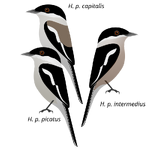| Locustellidae | |
|---|---|
| File:Striated Grassbird (Megalurus palustris) in Kolkata W IMG 3399.jpg | |
| Striated Grassbird, Megalurus palustris | |
| Scientific classification | |
| Kingdom: | Animalia |
| Phylum: | Chordata |
| Class: | Aves |
| Order: | Passeriformes |
| Superfamily: | Sylvioidea |
| Family: | Locustellidae Bonaparte, 1854 |
| Genera | |
| Diversity | |
| 15 genera, 60 species | |
| Synonyms | |
|
Megaluridae (Blyth, 1875) | |
Locustellidae is a newly recognized family of small insectivorous songbirds ("warblers"), formerly placed in the Old World warbler "wastebin" family. It contains the grass-warblers, grassbirds, and the Bradypterus "bush-warblers". These birds occur mainly in Eurasia, Africa, and the Australian region. The family name is sometimes given as Megaluridae, but Locustellidae has priority.[1]
The species are smallish birds with tails that are usually long and pointed; the scientific name of the genus Megalurus in fact means "the large-tailed one" in plain English. They are less wren-like than the typical shrub-warblers (Cettia) but like these drab brownish or buffy all over. They tend to be larger and slimmer than Cettia though, and many have bold dark streaks on wings and/or underside. Most live in scrubland and frequently hunt food by clambering through thick tangled growth or pursuing it on the ground; they are perhaps the most terrestrial of the "warblers". Very unusual for Passeriformes, beginning evolution towards flightlessness is seen in some taxa.[2]
Among the "warbler and babbler" superfamily Sylvioidea, the Locustellidae are closest to the Malagasy warblers, another newly-recognized (and hitherto unnamed) family; the Black-capped Donacobius (Donacobius atricapillus) is an American relative derived from the same ancestral stock and not a wren as was long believed.[1]
Genera[]
- Robsonius (2 species)
- Elaphrornis – Sri Lanka Bush-warbler
- Locustella – grass-warblers (24 species)
- Chaetornis – Bristled Grassbird
- Megalurus – Striated Grassbird
- Schoenicola – wide-tailed grassbirds (2 species; tentatively placed here)
- Amphilais: Grey Emutail
- Bradypterus – Megalurid bush-warblers (more than 20 species; paraphyletic[3]) - Dromaeocercus has been merged with it[4]
- Malia: Malia
- Cincloramphus – songlarks (2 species; tentatively placed here)
- Eremiornis – Spinifex-bird
- Poodytes: Little Grassbird
- Bowdleria – fernbirds (1 living species, 1 recently extinct; sometimes included in Megalurus)
- Buettikoferella – Buff-banded Bushbird
- Megalurulus – thicketbirds (5 species)
Footnotes[]
- ^ a b Alström et al. (2006)
- ^ del Hoyo et al. (2006)
- ^ At least one species - Victorin's Warbler - does not belong in the Locustellidae at all (Beresford et al., 2005).
- ^ John H. Boyd III (January 3, 2012). "SYLVOIDEA I: Stenostiridae through Loucestellidae". TiF Checklist. Retrieved 19-04-2024. Check date values in:
|access-date=(help)
References[]
| Wikimedia Commons has media related to: http://commons.wikimedia.org/wiki/Category:Locustellidae |
- Alström, P.; Ericson, P.G.P.; Olsson, U. & Sundberg, P. (2006): Phylogeny and classification of the avian superfamily Sylvioidea. Mol. Phylogenet. Evol. 38(2): 381–397. doi:10.1016/j.ympev.2005.05.015 PMID 16054402 PDF fulltext
- Beresford, P.; Barker, F.K.; Ryan, P.G.; & Crowe, T.M. (2005): African endemics span the tree of songbirds (Passeri): molecular systematics of several evolutionary 'enigmas'. Proc. Roy. Soc. Lond. B 272 (1565): 849–858. doi:10.1098/rspb.2004.2997 PDF fulltext Electronic appendix
- del Hoyo, Josep; Elliott, Andrew & Sargatal, Jordi (eds.) (2006): Handbook of Birds of the World (Volume 11: Old World Flycatchers to Old World Warblers). Lynx Edicions, Barcelona. ISBN 849655306X

|
This article is part of Project Bird Taxonomy, a All Birds project that aims to write comprehensive articles on every order, family and other taxonomic rank related to birds. |

|
This article is part of Project Bird Families, a All Birds project that aims to write comprehensive articles on each bird family, including made-up families. |
| This page uses Creative Commons Licensed content from Wikipedia (view authors). Please help by writing it in the style of All Birds Wiki! |
